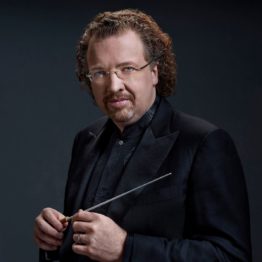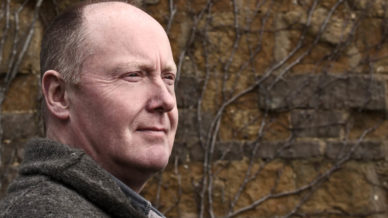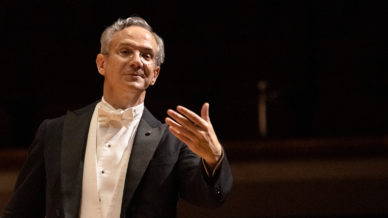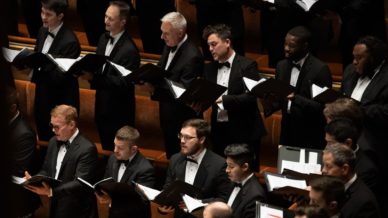

Symphonic Dances
September 22 – 24, 2022
STÉPHANE DENÈVE conducts
JEANINE DE BIQUE soprano
CONNESSON “Celephais” from Cities of Lovecraft
BARBER Knoxville: Summer of 1915
RACHMANINOFF Symphonic Dances
America from three distinct viewpoints is on display in this stirring concert. The fantasy world of horror writer H.P. Lovecraft inspired Connesson’s “Celephais.” James Agee’s poem depicting a summer evening in a sleepy southern town personally resonated with Barber — the combination of Agee’s words and Barber’s music is pure magic. Rachmaninoff blends his love of his new American home with nostalgia for his native Russia in his Symphonic Dances.
The three pieces come together to emulate America’s melting pot origins, with lush and energetic works starting off the program and leading to Rachmaninoff’s last major composition, the Symphonic Dances. Traverse the breadth and depth of each experience in this deeply moving program.

Program Notes
by René Spencer Saller
Guillaume Connesson’s wild and weird catalog covers all the major genres: works
for orchestra, chamber ensembles, solo instruments, voice (solo, choral, operatic)
and film. His scores draw from what he calls “the complex mosaic of the
contemporary world,” piecing together a harmonic collage from shards of
Beethoven, Messiaen, James Brown; Ravel and Reich; John Coltrane and John
Williams.
A master colorist, Connesson studied at the Conservatoire National de Région de
Boulogne-Billancourt and the Paris Conservatoire, winning first prizes in choral
direction, music history, analysis, electro-acoustic composition and
orchestration. After finishing his formal studies, he continued to collect awards and
honors, both in his native France and internationally, including the coveted Nadia
and Lili Boulanger Prize in 1999.
In 2017 Connesson completed his hallucinatory symphonic suite Cités de Lovecraft
(Cities of Lovecraft), a tripartite tone poem inspired by Howard Phillips (H.P.)
Lovecraft’s Dream Cycle. In Dream Cycle, the weird fiction icon lovingly delineated
his dreamscapes, a consciousness-recovery project involving hashish, the
subconscious, and the Romantic obsession with regaining the child’s perception,
that fresh, unmediated infusion of the sublime, flooding the senses.
Lovecraft described this project in “Celephais,” the Dream Cycle story that serves as
the title of Connesson’s first movement: “There are not many persons who know
what wonders are opened to them in the stories and visions of their youth; for when
as children we listen and dream, we think but half-formed thoughts, and when as
men we try to remember, we are dulled and prosaic with the poison of life.”
When “Celephais” ends, the dreamer, rechristened Kuranes, presides benignly over
his minaret-studded dream-dominion, worshiped as a god.
Connesson wrote Cités de Lovecraft to fulfill a 2016 commission from the
Netherland Philharmonic, which performed the world premiere. The first recording
of the work was released by Deutsche Grammophon, as part of the two-disc Lost
Horizon album, with Stéphane Denève conducting the Brussels Philharmonic; Lost
Horizon also featured Connesson’s Violin Concerto (Les Horizons Perdus). In 2019
the latter work earned the composer his second Victoire de la Musique Composer of
the Year Award.
A Closer Listen
Celephaïs is both the first movement of Cités and a fleet, shape-shifting tone poem in
its own right, boasting Technicolor tone-painting and Lovecraftian labels like “The
Rose-Crystal Palace of the Seventy Delights.” Throughout its richly imagined nine-
or-so minutes, it revels in Neoclassical contrasts and free-jazz interrogations,
pivoting from sweet to sour, tonal to dissonant, tragic to triumphal. Hectic
Stravinskyan riffs resolve into lurid fanfares; rants beget tender rhapsodies. The
movement ends as it began, in an ecstatic tizzy.
An Excerpt from Lovecraft’s “Celephaïs “:
“Kuranes [the dreamer] was now very anxious to return to minaret-studded
Celephaïs, and increased his doses of drugs; but eventually he had no more money
left, and could buy no drugs. Then one summer day he was turned out of his garret,
and wandered aimlessly through the streets, drifting over a bridge to a place where
the houses grew thinner and thinner. And it was there that fulfillment came, and he
met the cortège of knights come from Celephaïs to bear him thither forever.
[…]
” [A]nd then the luminous vapours spread apart to reveal a greater brightness, the
brightness of the city Celephaïs, and the sea-coast beyond, and the snowy peak
overlooking the sea, and the gaily painted galleys that sail out of the harbour toward
distant regions where the sea meets the sky.”—H.P. Lovecraft
The Composer Speaks
“This piece was born out of my fascination with the American writer Howard
Phillips Lovecraft. When the Netherland Philharmonic Orchestra asked me for a
piece, I wanted to write a grand symphonic poem about [him]. I already did this
when I was an adolescent—my very first orchestral piece was actually about
[Lovecraft], but I’d more or less put it aside for the past 20 years. Then I
rediscovered it and told myself that this was the moment to return to this universe.
What interested me was to create a grand fresco, with lots of color, somewhat
baroque, very explosive—and all this was present in Lovecraft. So I found the
images there that would feed my orchestral imagination.
Born in West Chester, Pennsylvania, to educated and affluent parents, Samuel
Barber seemed destined for a life in music. His aunt, the distinguished contralto
Louise Homer, and her husband, the composer Sidney Homer, were essential early
mentors. He started playing piano at age six; a year later he wrote Sadness for solo
piano. At nine he began his first opera and informed his mother, by letter, that “I was
not meant to be an athlet [sic]. I was meant to be a composer, and will be I’m sure.”
Before Barber had even entered his teens, he was serving as organist at a local
church. In 1924, at age 14, he enrolled in the newly opened Curtis Institute in
Philadelphia, where he would study piano, voice, composition, and conducting.
Curtis also brought him the love of his life, fellow student and composer Gian-Carlo
Menotti, who would become an essential collaborator. Barber was only 26 when he
wrote Adagio for Strings—by some accounts the most frequently performed piece of
American concert music from the 20th century. He was twice awarded the Pulitzer
Prize in Music: in 1958 for his opera Vanessa, and in 1963 for his Concerto for Piano
and Orchestra.
Knoxville Idyll
Barber completed Knoxville: Summer of 1915 in 1947. It was a commission from the
American soprano Eleanor Steber, who sang it at the world premiere, on April 9,
1948, with the Boston Symphony Orchestra led by Serge Koussevitzky. Early
reviews were somewhat disappointing, although the piece swiftly insinuated itself
into the core repertoire, thanks in part to transcendent readings by the likes of
Leontyne Price, Renée Fleming, Dawn Upshaw—and Jeanine de Bique.
Barber chose the text himself, for nostalgic reasons. “I had always admired Mr.
[James] Agee’s writing,” he wrote, “and this prose-poem particularly struck me
because the summer evening he describes in his native southern town reminded me
so much of similar evenings, when I was a child at home.”
Although Agee wrote the words from the perspective of a boy—who, like Agee, was
born and reared in Knoxville, Tennessee, surrounded by a supportive and creative
family—Barber’s setting is usually performed by a soprano, only rarely by a tenor.
(Tenor Russell Thomas sings a swoon-worthy recital version, in piano reduction,
which you are urged to seek out online.) Agee’s openly autobiographical text started
out as a prose-poem, published in a literary journal in 1938. After his death in 1955,
the prose-poem was posthumously recycled as the preamble to A Death in the
Family, which won the Pulitzer Prize three years later.
The year 1915 was especially significant for Agee because it was his last summer
with his father, who died after a sudden heart attack in 1916. Barber’s own father,
Roy Barber, died in 1947, as did his beloved Aunt Louise. That same year Barber
composed his setting of Knoxville: Summer of 1915, which he dedicated to his
father’s memory.
A Closer Listen
Leontyne Price’s oft-quoted remark that “you can smell the South in it” might be the
pithiest description of Knoxville: Summer of 1915. Barber identified its one-
movement form as “lyric rhapsody.” He noted that Agee’s prose-poem “expresses a
child’s feeling of loneliness, wonder and lack of identity in that marginal world
between twilight and sleep.”
The music, kissed by jazz and blues, seems to assemble itself, almost
improvisationally, from a woodwind-sung motif that burbles up like birdsong on a
summer evening. Despite sporadic honks and other urban racket, the mood of the
music is spellbound and sylvan, a midsummer night’s meditation. The rhythms are
easy, conversational: free verse slipping into stream-of-consciousness. When the
child succumbs to sleep, we trust that it will foster only pure and restorative visions.
The “lyric rhapsody” becomes a kind of benediction, as the child expresses his
gratitude and prays for his beloved family, then drifts off to sleep, suspended in
possibility.
Discouraged by the lackluster response to his Fourth Piano Concerto and his Third
Symphony, Sergei Rachmaninoff wrote nothing at all from 1937–39. He fretted
about his sickly daughter, complained about his grueling travel schedule as a
concert pianist, and struggled to balance the responsibilities of career and family.
But in the summer of 1940, at a rented estate in Long Island, the 67-year-old
virtuoso began to write what would become Symphonic Dances, his last completed
work. Now that he finally had space and leisure to focus on composing and
rehearsing, he did little else from 9:00 in the morning until 11:00 at night.
On August 21, he wrote Eugene Ormandy, the conductor of the Philadelphia
Orchestra and the eventual dedicatee: “Last week I finished a new symphonic piece,
which I naturally want to give first to you and your orchestra…. Unfortunately, my
concert tour begins on October 14. I have a great deal of practice to do, and I don’t
know whether I shall be able to finish the orchestration before November. I should
be very glad if, upon your return, you would drop over to our place. I should like to
play the piece for you.”
Despite his claim, the piece was unfinished. Even during his grueling concert tour,
Rachmaninoff continued to work on Symphonic Dances, orchestrating the third
movement and correcting proofs of the score at nearly every hotel stop. Rehearsals
went fairly smoothly, and Ormandy conducted the premiere on January 3, 1941.
Audiences were enthusiastic; critics were underwhelmed. The composer displayed
his usual dry, self-deprecating wit. As he ruefully noted in a newspaper interview, “It
should have been called just Dances, but I was afraid people would think I had
written dance music for jazz orchestra.”
Contested in Death
In 1942 Rachmaninoff revised his Fourth Concerto but wrote no new music.
Although he had been in touch with the influential choreographer Michel Fokine
about creating a ballet from the Dances, Fokine died that August. Then in February
1943, after a recital in Knoxville, Tennessee, Rachmaninoff became gravely ill from
symptoms caused by his newly diagnosed, long-untreated melanoma. On March 28,
when he was just a few days shy of 70, the newly minted American citizen died at
his home in Beverly Hills.
Although he had once expressed a wish to be interred in the same Moscow cemetery
where Scriabin and Chekhov were buried, Rachmaninoff’s remains ended up in
Valhalla, New York. According to his descendants, that was his stated final wish.
Since at least 2015, representatives from the composer’s family have successfully
fought a claim by the Russian government to repatriate Rachmaninoff’s remains, on
the grounds that his grave has been both neglected and “shamelessly privatized” in
his adopted country. “We are not planning to go against his will, so his remains will
stay where they were buried,” his great-great-granddaughter, Susan Sophia-
Volkonskaya-Wanamaker, stated to the BBC in 2015.
A Closer Listen
Rachmaninoff’s final score is an intensely autobiographical work, a summary of his
achievements—a valediction, if not a map of his psyche. The music is richly allusive
and intertextual: the poignant emergence of a theme from his First Symphony, that
crushing disappointment, at the end of the first movement; quotations in the third
movement from both the Gregorian Dies irae chant (to which he had returned
obsessively throughout his career) and the Russian Orthodox chant “Blessed Be the
Lord,” which he had previously used in his Vespers, from 1915; snatches of Slavic
melodies and dances throughout, as well as a possible nod to Rimsky-Korsakov’s
opera The Golden Cockerel, the only music by another composer that Rachmaninoff
brought with him when he left his native Russia in 1917.
Originally conceived as a ballet, Symphonic Dances evolved into a fully realized
orchestral work that represents Rachmaninoff’s late period at its opulent best. Rich
in eccentric harmonies, dramatic shifts in meter, and unusual instrumentation
(check out that alto saxophone solo in the first dance), it conjures up a multiverse of
emotion and expressive possibility, from the vaguely menacing and distinctly
uncheery Non allegro, to the spookily seductive central waltz, to the doomy but
euphoric finale.




